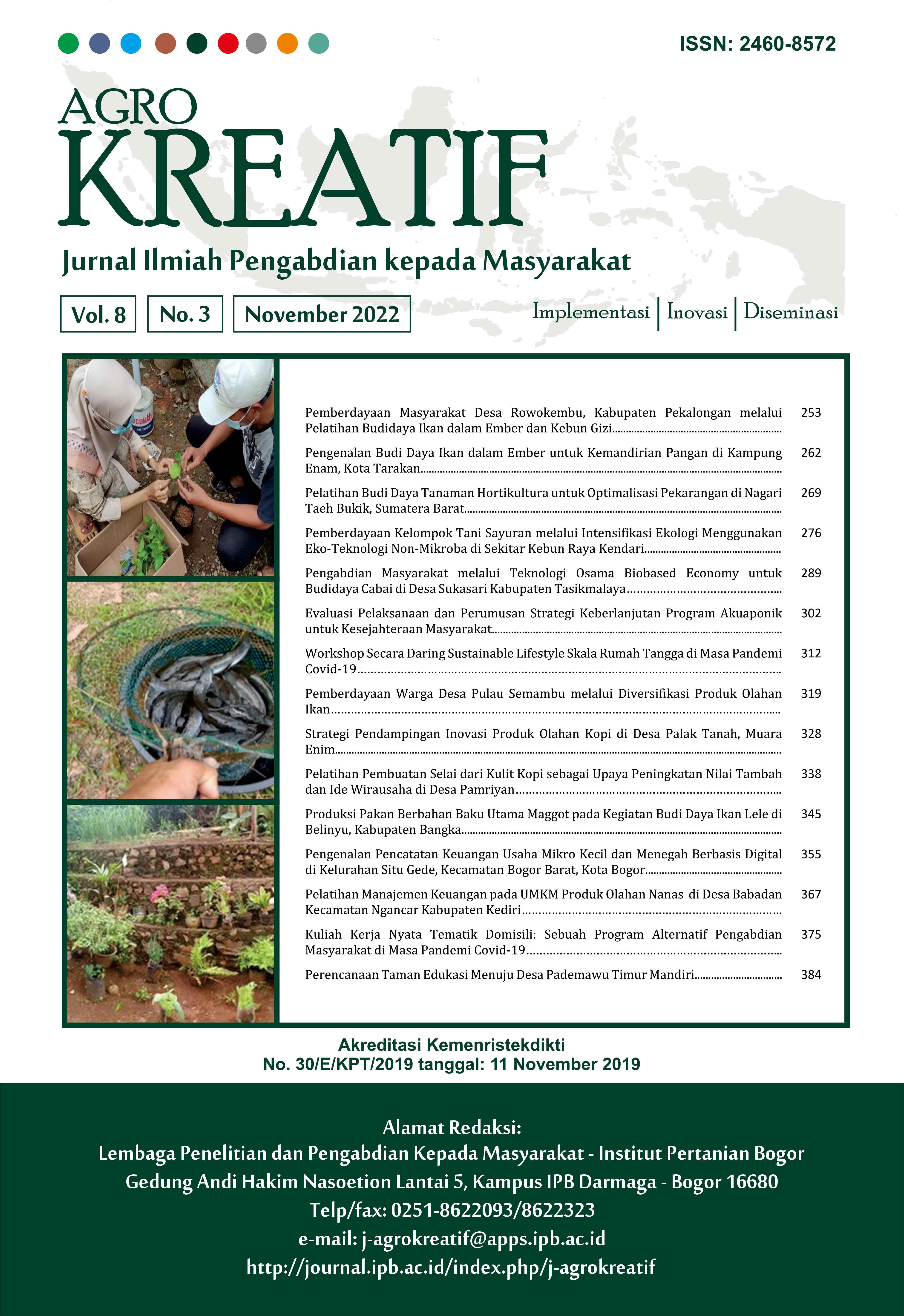Pelatihan Pembuatan Selai dari Kulit Kopi sebagai Upaya Peningkatan Nilai Tambah dan Ide Wirausaha di Desa Pamriyan
Abstract
Coffee is a superior commodity owned by Indonesia. One of the coffee producing areas in Central Java is in Pamriyan Village, Pituruh Subdistrict, Purworejo Regency with an area of 1009.75 ha. The high production of coffee produced is also followed by the high waste of coffee produced which is not currently utilized properly. On the other hand, the coffee rind has the potential as a food rich in antioxidants such as polyphenols, anthocyanins, tannins, plavanols, 3-ol flavans, hydroxionic acids, and kafrin. This activity aims to provide an overview of the potential of resources that can be developed in Pamriyan Village and provide insight into the added value of coffee waste as well as entrepreneurial ideas to improve the economy of pamriyan villagers. The activity was carried out with material delivery and direct practice of making Coffee Skin Jam (SEKUPI). In this SEKUPI practice activity, it was obtained that almost all participants liked the taste, texture, and packaging of coffee skin jam and all participants agreed that this product was worth selling and developing. Analysis of the calculation of the cost of production was obtained that each manufacture of 10 bottles of SEKUPI will produce a profit of Rp 66,300,00. Furthermore, the calculation of R/C value is obtained a result of 1.203 which means that the business provides profits and is worth developing. Trainees are very happy with this training activity because it has added to their insights and gained new business opportunity ideas to develop in Pamriyan Village.
Downloads
References
Asnidar, Asrida. 2017. Analisis kelayakan usaha home industry kerupuk opak di desa paloh meunasah dayah kecamatan muara satu kabupaten aceh utara. Jurnal Sains Pertanian. 1(1): 39‒47.
[BPS] Badan Pusat Statistik. 2019. Kabupaten Purworejo dalam Angka 2019. Purworejo (ID): BPS.
Dewi RP, Saputra TJ, Widodo S. 2021. Studi Potensi Limbah Kulit Kopi sebagai Sumber Energi Terbarukan di Wilayah Jawa Tengah. Journal of Mechanical Enginering. 5(1): 41‒45. https://doi.org/10.31002/jom.v5i1.3946
Esquivel P, Jimenez VM. 2012. Functional Properties of Coffe by Producetst. Food Research International. 46: 488‒495. https://doi.org/10.1016/j.foodres.2011.05.028.
Hartono. 2013. Produksi Kopi Nusantara Ketiga Terbesar di Dunia. Siaran Pers Kemenperin. www.kemenperin.go.id/artikel/6611/produksi-kopi-nusantara-ketiga-terbesar-di-dunia. [diakses 29 Oktober 2021]
[ICO] International Coffe Organization. 2017. Annual Review 2015‒2016. International Coffe Organization. London (UK): International Coffe Organization.
Juwita AI, Mustafa A, Tamrin R. 2017. Studi Pemanfaatan Kulit Kopi Arabika (Coffe arabica L.) Sebagai Mirkooranisme Lokal (MOL). Agrotek Jurnal Teknologi Ind Pertan. 11(1): 1–8. https://doi.org/10.21107/agrointek.v11i1.2937
Khalil M. 2016. Pengaruh Pemberian Limbah Kulit Kopi (Coffea sp.) Amoniasi sebagai Pakan Alternatif Terhadap Pertambahan Bobot Ayam Broiler. Jurnal Ilmiah Mahasiswa Pendidikan Biologi. 1(1): 119–130.
Launuru MR, Daningsih E. 2019. Pengembangan Selai Jagung Manis (Zea mays saccharate) dengan Konsentrasi Gula yang Berbeda. Jurnal Pendidikan Informatika dan Sains. 8(2): 179‒192). https://doi.org/10.31571/saintek.v8i2.1269
Marcelinda A, Ridhay A, Prismawiyanti. 2016. Aktivitas Antioksidan Ekstrak Limbah Kulit Ari Biji Kopi (Coffea sp) berdasarkan Tingkat Kepolaran Pelarut. Journal of Natural Science. 5(1): 21‒30.
Nurwidodo, Kurnia R, Dewi H, Evanila, Silvia. 2019. Karakteristik Fisik, Organoleptik, dan Kandungan Gizi Selai Kopi dengan Variasi Rasio Pencampuran dan Lama Pemasakan. [Skripsi]. Bengkulu (ID): Universitas Bengkulu.
Prapurti G, Wiendiyati, Bano M. 2019. Analisis Penentuan Harga Pokok dan Harga Jual Kopi Bubuk Arabik Flores Bajawa di Koperasi Papa Wiu Kelurahan Mangulewa Kecamatan Golewa Barat Kabupaten Ngada. Buletin EXCELLENTIA. 8(1): 20-28.
Simanihuruk, Kiston, Sirait J. 2010. Silase Kulit Buah Kopi Sebagai Pakan Dasar pada Kambing Boerka Sedang Tumbuh. Disampaikan pada: Seminar Nasional Teknologi Peternakan dan Veteriner. Sumatera Utara (ID) 2010.
Tania R, Widjaya S, Suryani A. 2019. Usaha Tani, Pendapatan, dan Kesejahteraan Petani Kopi di Lampung Barat. Jurnal Ilmu-Ilmu Agribisnis. 7(2): 149‒156. https://doi.org/10.23960/ jiia.v7i2.149-156
Valentiah FV, Listyarini E, Prijono S. 2015. Aplikasi Kompos Kulit Kopi untuk Perbaikan Sifat Kimia dan Fisika Tanah Inceptisol serta Meningkatkan Produksi Brokoli. Jurnal Tanah dan Sumberdaya Lahan. 2(1): 147‒154.
This work is licensed under a Creative Commons Attribution-NonCommercial 4.0 International License.



















